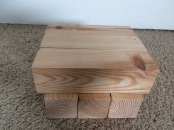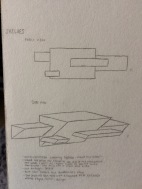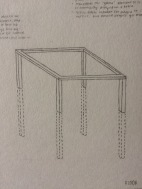Before any preparation for the whole display could begin, I had to decide how to display the Jenga tower, to avoid it toppling over, and to make it as though it had been partially played. I wanted to have a Jenga tower that was half way through a game as this makes it more intricate and prepared to fall over – the reason why the clay figures are running away.
The pieces are not attached together which also adds to this sense of precaution for the pieces, and also the viewer. I decided not to attach these pieces together as not only do I want to reuse the blocks, but I didn’t want to have the attachments showing, such as screws, or over spilt glue. However, it all reverts back to the sense that it could fall down any minute that makes it all exciting. This is also the reason why the piece won’t be interactive – because at any moment it could fall down and crush the clay figures.
Very quickly, I began to discover that there are several ways in which I could display my sculpture, and that these different ways of displaying, would give a different meaning to the piece. After a lecture on displaying and curating (yes, these are two different things), I found out about ways of displaying that I would never have thought of such as vitrines, and also whittled down my list to a few ways I wished to display;
- Shelving/a single shelf system
- Table (glass or solid)
- Floor (plain or with ‘childhood’ mats)
- Plinth/a series of plinths
I explored these ideas and used Adobe Photoshop and a drawing surface to determine whether there was any other environments that I could use to display the sculpture piece.
I was still unsure of how to display up to the point that I was writing my Artist Statement Draft and Artist Statement. It was here that I realised that I wanted people to bend down, to interact and to actually look at the piece. With the plinth, and often shelving or a table, there are certain implications and historic elements that you bring, even unintentionally to the sculpture. For example, if I displayed on a plinth, I would have also bought to the piece the history of displaying on a plinth. These associations are things that I did not want as part of the sculpture.
This led me to the conclusion that I wanted to display on the floor, to make people bend down, to interact and to actually look at the piece and think about what it means. Hence, I am displaying on the floor. This, on a side note, should hopefully give the Jenga tower some stability (if it is on a flat floor).
In order to get an idea of the number of clay people that I needed to make, I made a ‘floor plan’, and this helped to display on the floor in the studio.































Pingback: Making an impossible sculpture | Charlotte Abraham Art